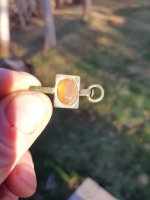ScottC
Jr. Member
- Jun 21, 2009
- 50
- 39
Since 1975, coinshooting was easier than it is now a days. I can remember going out coinshooting in my local area Northern CA, and simply driving around until I saw a good place to detect, empty lot, old park, old school yard etc... always finding silver indian heads and wheaties, among other interesting things, old tokens, locks, and occasional jewelery.
Today I decided to dust off the old White's 6000 Di Pro and and head out for a couple of hours, its been over 10 years since I've been out coinshooting, and after driving around for an hour, I discovered, there were a lot less places left to detect than I remember. Empty lots were fenced, new contruction sites were all fenced, in parks the original dirt has been dug and filled, those landscapers must have figured out there's treasure in that ground.
I finally decided on a wide old grass strip in from of a fenced empty lot, and man o man, so much trash, spent 2 hours there and came up with and old key lock from the 1930s and few clad coins, the silver is under all that trash.
Used to always come back from an outing with at least one silver coin, I think I've lost my touch, or is it really much more difficult to find good places to coinshoot
ScottC Sac CA
http:www.goldfinds.com
Today I decided to dust off the old White's 6000 Di Pro and and head out for a couple of hours, its been over 10 years since I've been out coinshooting, and after driving around for an hour, I discovered, there were a lot less places left to detect than I remember. Empty lots were fenced, new contruction sites were all fenced, in parks the original dirt has been dug and filled, those landscapers must have figured out there's treasure in that ground.
I finally decided on a wide old grass strip in from of a fenced empty lot, and man o man, so much trash, spent 2 hours there and came up with and old key lock from the 1930s and few clad coins, the silver is under all that trash.
Used to always come back from an outing with at least one silver coin, I think I've lost my touch, or is it really much more difficult to find good places to coinshoot
ScottC Sac CA
http:www.goldfinds.com


 )
) 





